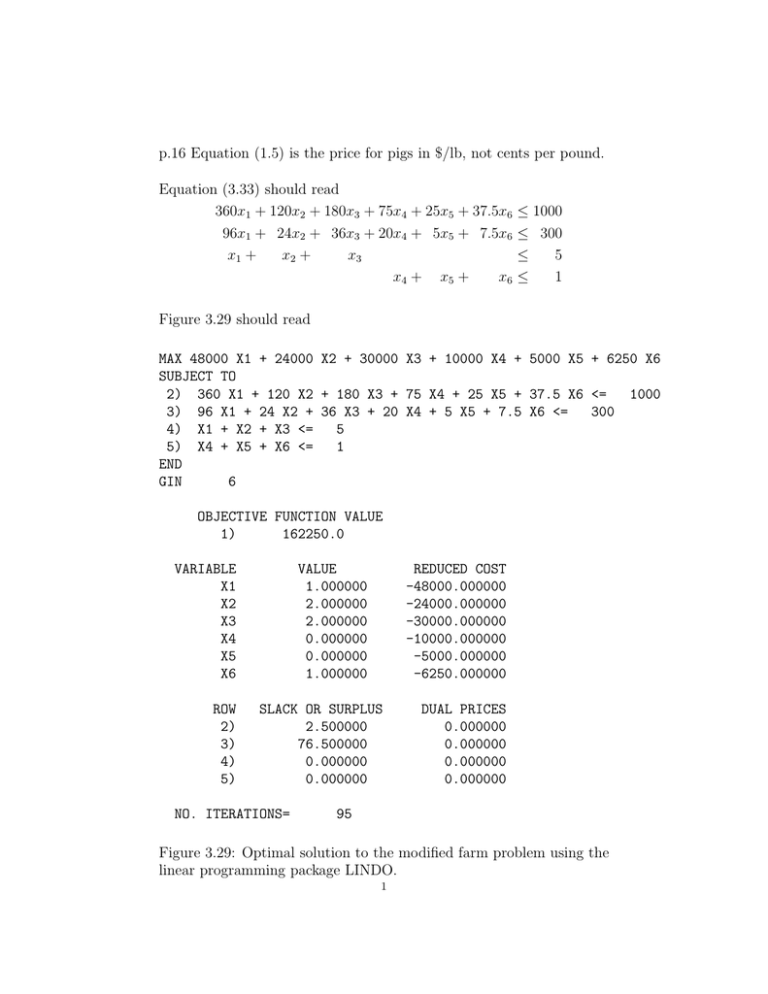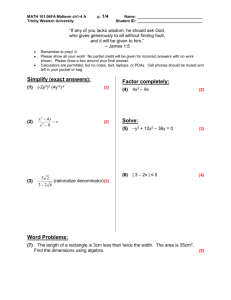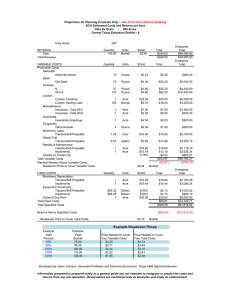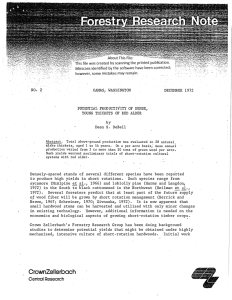p.16 Equation (1.5) is the price for pigs in $/lb,... Equation (3.33) should read ≤ 1000
advertisement

p.16 Equation (1.5) is the price for pigs in $/lb, not cents per pound. Equation (3.33) should read 360x1 + 120x2 + 180x3 + 75x4 + 25x5 + 37.5x6 96x1 + 24x2 + 36x3 + 20x4 + 5x5 + 7.5x6 x1 + x2 + x3 x4 + x5 + x6 ≤ 1000 ≤ 300 ≤ 5 ≤ 1 Figure 3.29 should read MAX 48000 X1 + 24000 X2 + 30000 X3 + 10000 X4 + 5000 X5 + 6250 X6 SUBJECT TO 2) 360 X1 + 120 X2 + 180 X3 + 75 X4 + 25 X5 + 37.5 X6 <= 1000 3) 96 X1 + 24 X2 + 36 X3 + 20 X4 + 5 X5 + 7.5 X6 <= 300 4) X1 + X2 + X3 <= 5 5) X4 + X5 + X6 <= 1 END GIN 6 OBJECTIVE FUNCTION VALUE 1) 162250.0 VARIABLE X1 X2 X3 X4 X5 X6 ROW 2) 3) 4) 5) VALUE 1.000000 2.000000 2.000000 0.000000 0.000000 1.000000 REDUCED COST -48000.000000 -24000.000000 -30000.000000 -10000.000000 -5000.000000 -6250.000000 SLACK OR SURPLUS 2.500000 76.500000 0.000000 0.000000 NO. ITERATIONS= DUAL PRICES 0.000000 0.000000 0.000000 0.000000 95 Figure 3.29: Optimal solution to the modified farm problem using the linear programming package LINDO. 1 2 The optimal solution is y = 162, 250 which occurs when x1 = 1, x2 = 2, x3 = 2, x6 = 1, and the other decision variables are all zero. Step 5 is to answer the question. If the family does not wish to split up individual plots (plan B), then the best plan is to plant one 120 acre plot of corn, two 120 acre plots of wheat, two 120 acre plots of oats, and one 25 acre plot of oats. This results in an expected total yield of $162,250 for the season. This is about 0.2% less than the projected total yield of $162,500 if we allow more than one crop per plot (plan A, the optimal solution found in Example 3.4). Plan A uses all of the acreage available, all of the irrigation water available, and all but 62.5 of the 300 person–hours of labor available each week. Plan B uses all of the acreage available, 997.5 of the 1000 available acre–feet of irrigation water, and only 223.5 of the available 300 person–hours of labor available each week. We leave it to the family to decide which plan is best. Figure 3.30 should read MAX 48000 X1 + 24000 X2 + 30000 X3 + 10000 X4 + 5000 X5 + 6250 X6 SUBJECT TO 2) 360 X1 + 120 X2 + 180 X3 + 75 X4 + 25 X5 + 37.5 X6 <= 1100 3) 96 X1 + 24 X2 + 36 X3 + 20 X4 + 5 X5 + 7.5 X6 <= 300 4) X1 + X2 + X3 <= 5 5) X4 + X5 + X6 <= 1 END GIN 6 OBJECTIVE FUNCTION VALUE 1) VARIABLE X1 X2 X3 X4 X5 X6 ROW 172000.0 VALUE 1.000000 1.000000 3.000000 1.000000 0.000000 0.000000 SLACK OR SURPLUS REDUCED COST -48000.000000 -24000.000000 -30000.000000 -10000.000000 -5000.000000 -6250.000000 DUAL PRICES 3 2) 3) 4) 5) 5.000000 52.000000 0.000000 0.000000 NO. ITERATIONS= 97 0.000000 0.000000 0.000000 0.000000 Figure 3.30: Optimal solution to the modified farm problem with an additional 100 acre–feet of water available. Now we plant one 120–acre plot and one 25–acre plot of corn, one 120–acre plot of wheat, and three 120–acre plots of oats. Our optimal solution is quite sensitive to the amount of irrigation water available, even though this constraint was not binding in our original IP solution. The new plan yields an additional $9,750 in expected revenue. Figure 3.31 should read: MAX 48000 X1 + 24000 X2 + 30000 X3 + 10000 X4 + 5000 X5 + 6250 X6 SUBJECT TO 2) 360 X1 + 120 X2 + 180 X3 + 75 X4 + 25 X5 + 37.5 X6 <= 950 3) 96 X1 + 24 X2 + 36 X3 + 20 X4 + 5 X5 + 7.5 X6 <= 300 4) X1 + X2 + X3 <= 5 5) X4 + X5 + X6 <= 1 END GIN 6 OBJECTIVE FUNCTION VALUE 1) VARIABLE X1 X2 X3 X4 X5 X6 ROW 2) 3) 156250.0 VALUE 0.000000 0.000000 5.000000 0.000000 0.000000 1.000000 SLACK OR SURPLUS 12.500000 112.500000 REDUCED COST -48000.000000 -24000.000000 -30000.000000 -10000.000000 -5000.000000 -6250.000000 DUAL PRICES 0.000000 0.000000 4 4) 5) 0.000000 0.000000 NO. ITERATIONS= 98 0.000000 0.000000 Figure 3.31: Optimal solution to the modified farm problem with 50 acre–feet less water available. The optimal IP solution is to plant oats on all 625 acres. We use all but 12.5 acre–feet of water, and all the land, but we have 112.5 person– hours of labor per week to spare. The expected total yield is $156,250, which is only $6,000 less than before. This illustrates the unpredictable nature of IP solutions. For a 5% decrease in the amount of available irrigation water, instead of planting 360 acres of corn and wheat, we should plant oats everywhere. p.99 The 10-cubic-yard trucks take 20 minutes to load, and the 20cubic-yard trucks take 30 minutes to load. The labels R and C should be swapped on Figure 5.6. p.235 The interval (7.24) contains 1 for any value of n between 147 and 199. Change 198 to 199 (twice).




